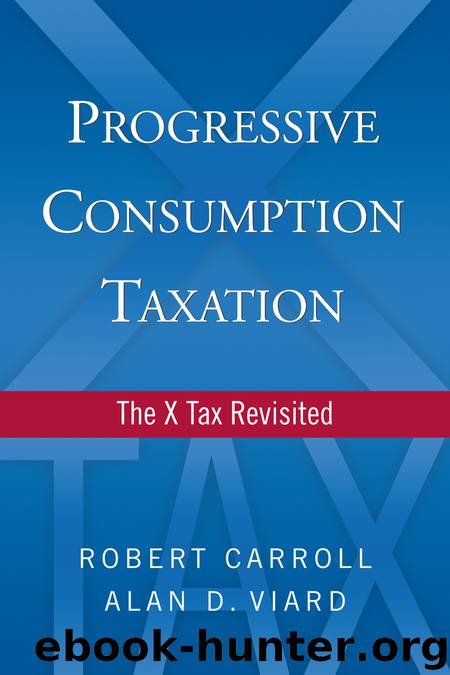Progressive Consumption Taxation by Viard Alan D.; Carroll Robert; & Alan D. Viard

Author:Viard, Alan D.; Carroll, Robert; & Alan D. Viard [Carroll, Robert]
Language: eng
Format: epub
ISBN: 948656
Publisher: AEI Press
Accounting Methods
Many transactions in the nonfinancial sector, such as sales on credit, involve a bundling of real and financial transactions. Suppose, for example, that a firm sells apples to a consumer at a stated price of $100 and gives the consumer one year to pay the $100 without any stated interest. Also assume that the consumer makes the $100 payment on schedule. To tax consumer purchases, the X tax system should ideally impose tax at the sale date on the value of the apples. Unfortunately, that value is not readily determinable, although it is clear that it must be less than $100. In economic terms, the $100 payment includes an interest payment to compensate for the deferral of payment, even though the firm has chosen not to label any of the payment as interest. If tax is to be imposed at the sale date, the tax should not apply to the interest component of the $100 payment, as the X tax ignores interest income and expense. The tax should apply only to the underlying value of the apples.
As Bradford (1996a) notes, however, a simple solution is available. It once again involves the R+F cash-flow method, which, in this context, simply means using a cash method of tax accounting. The cash method taxes all of the cash flows arising from the sale of the apples when the cash flows occur; in this example, that involves imposing no tax on the sale date and instead taxing the firm on the $100 payment when it is received. The cash method works because the present value of the deferred $100 payment must be equal to the value of the apples on the sale date. The cash method continues to work in the presence of default risk, just as it did for the bank loan discussed above, because the expected present value of the uncertain future payment equals the value of the apples on the sale date. If there is a risk of default, the firm increases the stated price to compensate for the possibility that no payment will be received. The cash method then taxes the increased payment if the increased payment is received and taxes nothing if nothing is received; the expected present value of what is taxed then necessarily equals the value of the apples on the sale date.
So, the cash method imposes no tax and offers no deduction when goods are exchanged for a receivable or payable. Instead, inclusions or deductions are made with respect to all future cash generated by the receivable or payable. Under the cash method, it is not necessary to specify a time at which the sale is deemed to have occurred; only the dates of receipts and payments need be determined.
For example, a firm that sells on credit is not taxed at the time of sale. Instead, it is taxed when it collects on the resulting account receivable, regardless of whether the collection is labeled as principal or interest. If it does not collect, due to the buyer's default, no tax is paid.
Download
This site does not store any files on its server. We only index and link to content provided by other sites. Please contact the content providers to delete copyright contents if any and email us, we'll remove relevant links or contents immediately.
Zero to IPO: Over $1 Trillion of Actionable Advice from the World's Most Successful Entrepreneurs by Frederic Kerrest(4054)
Machine Learning at Scale with H2O by Gregory Keys | David Whiting(3627)
Harry Potter and the Goblet Of Fire by J.K. Rowling(3609)
Never by Ken Follett(3528)
Ogilvy on Advertising by David Ogilvy(3332)
Shadow of Night by Deborah Harkness(3174)
The Man Who Died Twice by Richard Osman(2808)
Book of Life by Deborah Harkness(2719)
My Brilliant Friend by Elena Ferrante(2703)
How Proust Can Change Your Life by Alain De Botton(2613)
0041152001443424520 .pdf by Unknown(2595)
Will by Will Smith(2580)
The Tipping Point by Malcolm Gladwell(2559)
How to Pay Zero Taxes, 2018 by Jeff A. Schnepper(2500)
Purple Hibiscus by Chimamanda Ngozi Adichie(2485)
Hooked: A Dark, Contemporary Romance (Never After Series) by Emily McIntire(2422)
Rationality by Steven Pinker(2149)
Borders by unknow(2117)
Daughter of Smoke and Bone by Laini Taylor(2081)
